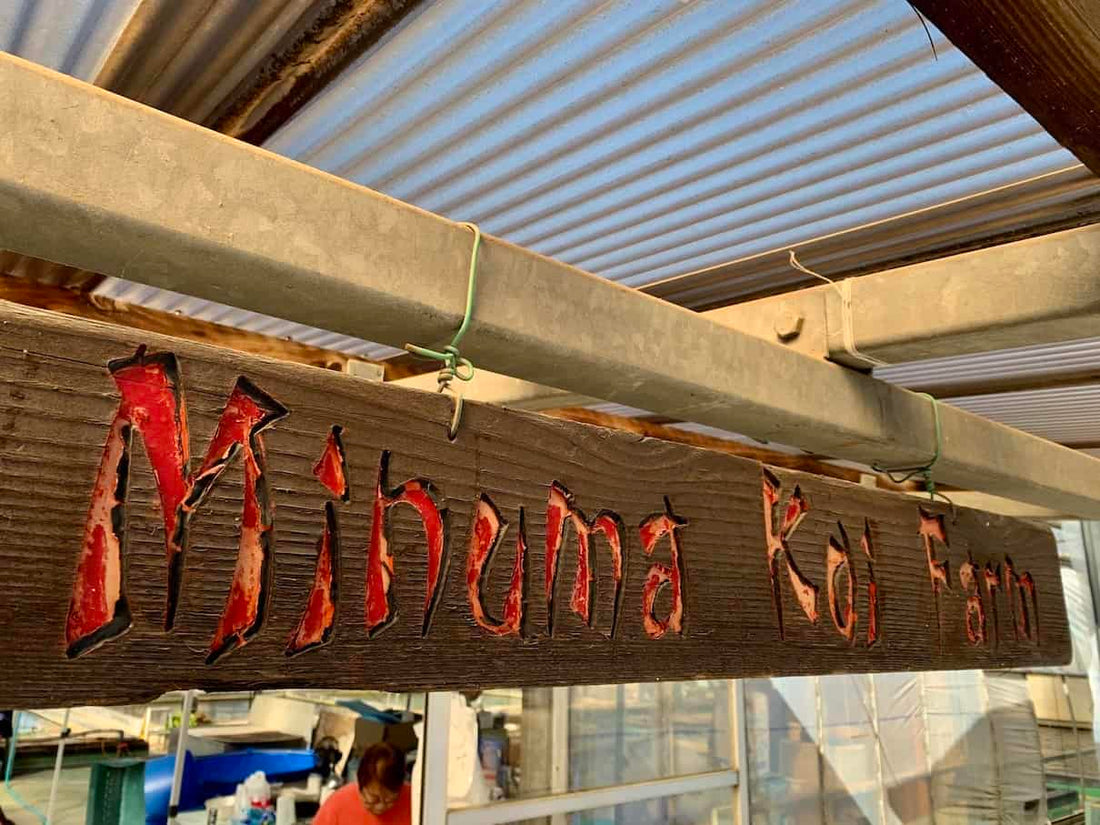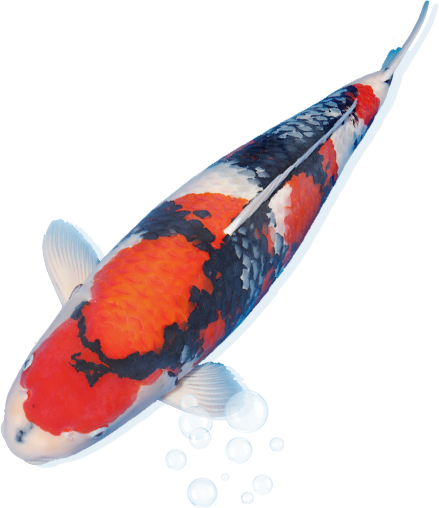
Share
Today we would venture to farms we haven’t visited before. Driving towards Saitma which is just north of Tokyo took around 3 hours to get to. Here Minuma Koi Farm. Specialising in Goshiki, his koi are very very sought after. Giving us a tour of the farm it became apparent that there wasn’t a huge amount of Koi for sale.
[gallery ids="21574,21575,21576,21577" type="rectangular"]
Kinichi Wada the owner of the farm showed us the Nisai for sale pond, in here there was some awesome Goshiki the best we’d seen for a while. Pointing out one in particular, it turned out it was already sold. Okay onto the next, again it was sold. This happened a dozen times or so. Japanese logic saying these koi are for sale, yet mixing sold fish in with the for sale Koi. It was getting all a bit mind numbing, then finally we managed to bowl fish that were for sale. Recognising a few fish that were for sale at an Odakan event a couple of weeks ago I knew these were going to be very expensive. Managing to get a price on each Koi these were going to be either a moment of madness or financial suicide. Starting at a few thousand up to nearly 5 figures. Bonkers.
[wpvideo sHldm7GD]
Having followed Minuma Goshiki for a few years I’ve always been a fan of them. Wada-san was very welcoming and friendly so I took the opportunity to ask him a series of questions about his Koi, Oyagoi, how he keeps them, water parameters and other things. Showing us on his IPad he had numerous photos of past winners at the All Japan, from 12cm award winners to 85cm winners. Flicking through the photos he started to explain about his different parent sets. At Minuma you can find a few variants of Goshiki. Below are a couple of development photos exhibiting Kuro and Mameshibori style Goshiki.
Asking about his water and methods of keeping Koi he explained that the water in his area was a lot harder than in Niigata. The pH was also higher typically around 7.5 to 7.8 which is the same as what we have at the shop. Wada-san went on to talk about his keeping methods. Most people that buy his fish leave them at the farm as azukari, for Tosai and Nisai they grow on in mud ponds, then for Sansai and above he grows them in his inside ponds.

I’m sure we’ll be back to Minuma at some point in future, for now we said thank you for his time and goodbye. A really impressive place, much bigger than anticipated.. However the Koi that were of interest just weren’t suitable for the U.K.
Moving on from Minuma the plan was to head to Isawa where we’d stay overnight then the following morning go to Maruyama Koi Farm. It was only around midday so we had a quick search of Isawa Nishikigoi Center and Sakuma which were in the direction we were heading. Once at Isawa we stopped off at INC. INC was set up by Toshio Sakai after the passing of his Father. His Father handed Yamamatsu Koi Farm down to Toshiyaki who still runs the farm in Niigata today. Toshio however, moved South and set up INC (Isawa Nishikigoi Centre). INC and Yamamatsu still work closely together, the majority of of INC’s mud ponds are in Niigata. The main koi house is situated in the middle of Isawa. It seemed a strange setting to have a Koi Farm. Not what we were use to. Viewing various ponds, there wasn’t much to look at unfortunately apart a couple of ponds by the office. Some nice Koi in these with the trademark Matsunosuke Gin which is famous around the world. It would seem that the Sanke’s here although nice just lacked modern patterns and bigger bodies. The majority of Sanke breeders have this bloodline somewhere in their Koi genetically. It would seem other breeders have just taken Sanke to a different level.

A short drive away we went to Sakuma Koi Farm. Breeder of Kohaku, Showa, Gin Rin Showa, Doitsu Showa and a handful of other varieties. Being shown around the farm it was clear they bred good Koi. There wasn’t masses of Koi to look at, but the majority of them were tidy looking Koi. We weren’t going to buy here but it was good to have a look.
Now to the hotel to catch up on some work and sleep! Our first day without buying a single Koi! Shock. Tomorrow we go to Maruyama, then make our way back to Niigata. We hope Maruyama meets our expectations. Before we found somewhere to eat, we had bit of fun on a driving range. 500 balls later, we discovered muscles we didn’t know existed. Good fun! Going to ache tomorrow.
Waking up to a beautiful Sunny morning. Through the mountain range we could see the top of Mount Fuji. Snow capped pretty much all year round it’s always nice to see it even if the view was restricted by other peaks. With the morning mist the camera couldn't quite pick it up.
First stop today was Maruyama Koi Farm. Breeder of Kohaku and Showa. His famous kohaku bloodline which links closely to Dainichi. The Beni on Maruyama Koi is renowned for being vibrant, silky and thick. Futoshi-Maruyama greeted us with big smiles and a tray of drinks for our arrival. First we were shown around the farm. The first house we went into contained Sansai And Yonsais for sale, as well as sold Koi and azukari Koi. Looking at the for sale ponds, the quality was outstanding. Superb bodies, Rich Beni and brilliant whites. We weren’t looking for any Sansai of this quality but we thought we’d ask for prices on a couple just to gauge how his pricing is. Pleasantly surprised at prices we were eager to get to the Nisai house. From the first 20 minutes of being at the farm we all had a really good feeling about this place. Well organised, good fish, nice pricing, clean and we could sense Maruyama was quite laid back in his approach.
Selecting through his Nisai we started off in the Female ponds. The ponds I was interested in contained Koi of mixed prices. So I started pointing out Koi to be bowled. In the bowl were mainly Kohaku, along with a couple of Showa. One thing that really stood out on these Koi was the beni quality. All thick, rich and glossy Beni. As the sun beamed through the bowl the Koi illuminated. The first 5 Koi here are all staying as Azukari. Maruyama-san Kindly offered a total guarantee on these. If they die, turn male, lose their colour, get covered in secondary, develop any kind of issue he will replace. Very generous! Not all breeders operate like this so it was a no brainer to leave these here till Sansai. It also means we have to come back next year to see their progress, and buy more Koi! Along with the 5 azukari Koi, I chose 3 other Females that will be coming back to the U.K. along with 4 outstanding Male Koi. Easily the best quality Males we’ve seen this trip for the money. The beni was fantastic on the females, on the males it was blinding! Extremely happy with the Koi, the farm and the prices we all had big grins on our faces. It certainly made up for yesterday!
These are the 3 Female, and 4 males selected.
[gallery ids="21597,21598,21599,21600" type="rectangular"]
The view from Maruyama Koi Farm as we were leaving. Fuji-san!

It was relatively early on in the day still but we had a lot of ground to cover to get back to Nagaoka. We said our goodbye and thank you to Maruyama for his time. Jumping in the car we hit the highway and headed North to the coast, then West along the coast to Toyama. Here we visited Nagoshi Koi Farm. Unfortunately we didn’t make any purchases here as they didn’t quite have the quality we were looking for. Maybe next time. The sun started to make it’s descent behind the nearby mountain ranges so we decided it was time to head back to Nagaoka.
Back to Niigata we were in familiar territory again. Tomorrow we'll be at Oofuchi, Hoshikin and Maruboshi.




















